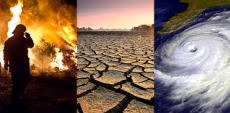

Around the age of the dinosaurs it used to be a lot hotter (100 million years ago). Average temperature has changed-decrease-increases/
Global warming could be responsible for changing climate
1.8 Million years ago we went through an Ice Age
Since 1850 our temperature has risen by 1 degree
Physical causes of climate change
Solar variation- the suns output varies slightly from time to time -its size is even known to change by a fraction as it expands and contracts e.g. if the sun gets bigger, the temperature will rise, if it gets smaller the temperature will decrease
sunspots: an increase in sunspot activity may lead to a very slight increase in the sun’s output and a temporary warming of the earth. Sunspot activity follows 11 and 22 year cycles. The little Ice Age of 1450-1700 may have been linked to periods of very low sunspot activity.
Volcanic eruptions
Eruptions of volcanoes can throw millions of tonnes of ash, dust and sulphur dioxide into the atmosphere. This produces aerosols that can reduce the amount of sunlight reaching the earth. This can lead to a temporary cooling of the earth.
Major eruptions in the past which have been linked to short periods of global cooling include Tambora (1815), Krakatoa (1883), Mt St Helens (1980) and Pinatubo (1991).
When mount Pinatubo erupted in 1991 an estimated 22 million tons of ash was thrown into the atmosphere, cooling the worlds climate by about 1 degree Celcius.
Milankovitch cycles
What are they?
They are 3 variations in the earth’s orbit. Although they may be linked to very long term changes in the climate, their effect would not be noticed on a scale of a few hundred years.
Question and Answers
What do we call significant changes in climate over millions of years? Geological climate events
How do we collect evidence of the physical changes in temperature? Diaries, paintings, boots and very old newspapers can all provide a pretty reliable picture of the Little Ice Age and the years followed. Some scientists study old wood, examining tree rings (because a cold year brings less new growth and thinner rings.) We also get clues from old coral reefs (because when seas were cooler, coral grew more slowly).
What was the most recent change for plant and animal life?
What impact did this have on the UK and USA? The most recent major change for plant and animal life was the extinction of certain large animals could megafauna at the end of the last Pleistocene Ice Age. As its coldest, climate change had left the UK covered in Ice as far South as what is now the Midlands. It was not just the UK that was affected of course, as changes were global. What are now the central states of the US were ice-bound too. However, a warming of the Earth’s climate was well under way by 10,000 years ago, probably linked to the orbit changes discussed earlier. The ice that covered that covered the UK and much of Northern Europe retreated to its present-day Arctic limit.
Image-
https://climate.nasa.gov/effects/

0 Comment:
Be the first one to comment on this article.